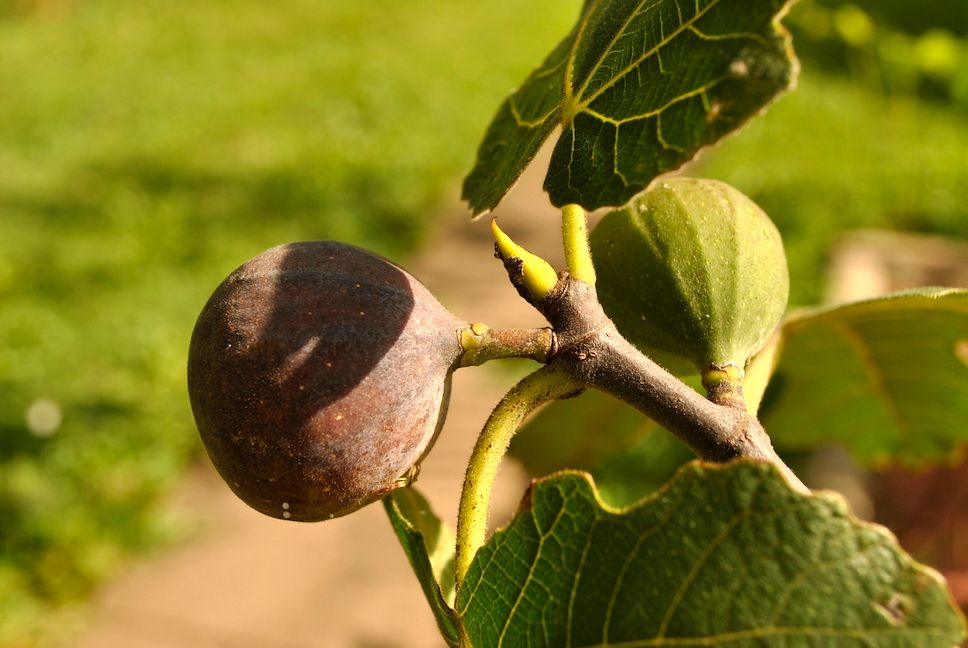How to Tell When Figs Are Ripe

If you have asked yourself, "When are figs ripe?", then follow these three tips to identify ripe figs on your trees and enjoy fresh figs at their peak.
Common figs are fruits that are enjoyed fresh or dried, and they are easy to grow. Use these tips and your senses to know when your figs are ripe and ready to harvest.
» If birds and other critters keep you from harvesting your ripe figs, consider applying garden netting to protect the fruit.
3 Ways to Identify Ripe Figs
Sight
Go by the color. One of the first signs your figs are becoming ripe is their change in color. Young, immature and unripe figs tend to be small and green in hue. For varieties like Brown Turkey, Chicago Hardy, Celeste, and LSU Purple, the color will change from green to brown or purple as the fruit ripens. In the case of certain fig varieties, like Kadota and LSU Gold, the fruit's mature color is still greenish – so how do you rely on sight if the fig's color doesn't noticeably change? Read on!

Go by the appearance. The fruit itself will hang in a droopy way on the tree as it ripens. This is true for figs regardless of mature color. Young, firm figs tend to stand out and away from the tree. As it ripens and softens, the fig will bend at the stalk where it is attached to the tree.
Go by the size. As the fruit matures on the tree, it will also grow in size*. The mature size depends on the variety you are growing, but the figs will all increase in size as they begin to mature and ripen on the tree.
*If the fruit does not grow in size, the tree may be overbearing (consider thinning out some fruit to reduce the load) or it may be lacking sufficient water. It may also be too cold to encourage ripening, especially later in the season and in cool climates.
Touch
A ripe fig will be soft to the touch when gently squeezed. Unripe figs are still firm. This is because the ripening process has not yet taken place, and the juices and sugars that are produced as the fruit ripens are not fully present.

Taste
Ripe figs are delightfully rich and sweet with a soft, smooth texture when they are fresh from the tree. Unripe figs can be rubbery, dry, and lack sweetness. The most effective way to tell your figs are unripe is to eat one before its peak. Most people only eat an unripe fig once before deciding to wait and allow figs to fully ripen before harvesting.

Taste
Ripe figs are delightfully rich and sweet with a soft, smooth texture when they are fresh from the tree. Unripe figs can be rubbery, dry, and lack sweetness. The most effective way to tell your figs are unripe is to eat one before its peak. Most people only eat an unripe fig once before deciding to wait and allow figs to fully ripen before harvesting.
How to Harvest Figs
When harvesting figs, you will notice that a ripe, fresh fig will come away from the tree with ease. Simply hold the base of the fruit in your hand and lift it up and away from the tree.
In some cases, really ripe figs may even drop to the ground from their increased size and weight if not picked first.
If the stalk develops a milky white sap once the fig is picked, then the fruit is not yet completely ripe; however, if the fig has a fully ripe color, has grown in size, and is soft to the touch, it may still be sweet and edible despite the appearance of some milky white sap. Our advice here is to try one and see how it tastes. If it is not very sweet or flavorful, try leaving the rest of the ripe figs on the tree another day or so.
Note: It is not recommended that you harvest unripe figs and try to ripen them off the tree. While the unripe fruit may soften after a few days at room temperature, it may not be ideal for palatability. However, this may be something to consider in northern areas, where frost or cool temperatures might prevent a later crop of figs from ripening on the tree.
Sometimes ripe figs will drip with juice/nectar while still on the tree – this is another sign they are ready to be harvested!

Fig Fruit Facts
It's important to know that the figs on a fig tree may not all ripen at once. Some fig tree varieties even set more than one crop, commonly called the "breba" (fruit on last year's growth) and "main crop" (fruit on current year's growth). In fig trees with more than one crop, like Chicago Hardy and Brown Turkey, the breba crop ripens first, early in the season, followed later by the main crop.
Grow Your Own Fig Trees
Shop by State
Customize your plant selection based on your area's unique growing zones by exploring our top recommendations for trees and plants. Select your state to discover the best options.


